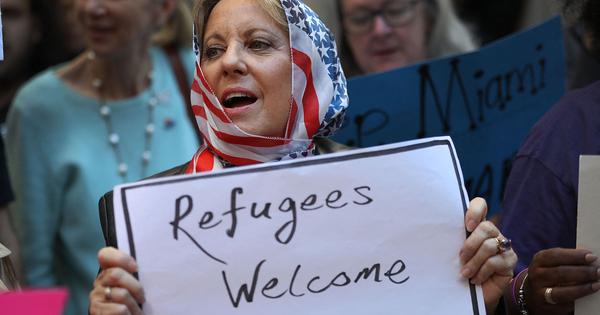
As US President Donald Trump has hypercharged his campaign against undocumented immigrants, supporters of the sanctuary movement that started in the 1980s to protect refugees have intensified their efforts to draw more organisations into their networks.
In the early days of the sanctuary movement, individual churches would offer shelter to undocumented immigrants who had exhausted their legal options to remain in the country. It expanded to entire cities, such as New York, San Francisco, Chicago and Los Angeles, which adopted sanctuary policies that limit federal immigration enforcement.
Ravi Ragbir, who heads the New York-based New Sanctuary Coalition, an immigrant rights organisation, explains the idea of sanctuary has always been rooted in faith traditions of welcoming strangers. That is why he is pushing to get gurudwaras and Hindu temples to join the network.
“It is this sense of religious hospitality that helped the movement thrive in the 1980s,” said the immigrant from Trinidad.
Advocating for the rights of undocumented immigrants is not a popular position. Since Trump began his second term in January, 197,000 people have been deported from the US, while 61,000 are in detention for allegedly having broken immigration laws. Trump’s supporters have applauded his actions and have called for even harsher measures.
In March, the Trump administration rescinded the “sensitive locations” memo, a policy that prevented immigration authorities from entering hospitals, schools and houses of worship.
Within a week of the rescission, immigrant agents appeared at a Latino Pentecostal church outside of Atlanta, remotely activated the ankle monitor of the church founder (a GPS tracking device that the authories had required him to wear) and arrested him as soon as he stepped outside the church.
The church founder, like many immigrants seeking protection, had applied for asylum since he faced persecution in his home country of Honduras but was still waiting for a court decision.
In 1985, when San Francisco passed one of the first sanctuary policies, it was called the “City of Refuge” – a reference that reflected the movement’s origins in churches that sheltered Central American refugees fleeing civil wars.
While the sanctuary movement went dormant in the 1990s and early 2000s, it was revived when Trump was first elected in 2016. Within two years, the number of sanctuary churches and temples in the US jumped from 400 to more than 1,100.
While many sanctuary city policies predated Trump – New York’s sanctuary laws date to 1989 – his election pushed activists to fight for stronger protections. Some cities like Hartford in Connecticut declared sanctuary status in 2016.
For Ragbir, this is familiar territory – having fought against his own deportation for over two decades.
Though he arrived in the United States in 1991 and became a permanent resident in 1994, he had been convicted in 2001 of a wire-fraud conviction connected to fraudulent loan applications submitted by another person at the company where Ragbir worked as a salesman. Wire fraud is a federal crime in the US that involves using electronic communications to deceive someone and steal money or property.
Ravi served a two-and-half year sentence, followed by two years in immigrant detention.
The federal judge noted that Ragbir was “a casualty” of another man’s fraud scheme at the company where he worked as a salesman. But this left his permanent residency in the US subject to review.
Ragbir believed his activism work with immigrant rights groups made him a particular target for the Immigration and Customs Enforcement, the federal agency at the centre of the immigration crackdown.
A federal appellate court later ruled that he had presented compelling evidence that ICE targeted him in retaliation for his advocacy work, violating his constitutional right to free speech.
It was not until the US President Joe Biden pardoned Ragbir in his final days in office in January that the case came to a close.
When ICE arrested Palestinian student Mahmoud Khalil at Columbia University on March 8 and flew him to a detention centre in Louisiana, it echoed tactics used by ICE in Ragbir’s case.
In 2018, ICE had flown Ragbir to Miami – a move to separate him from his legal team and place his case before judges more favourable to the government.
“Their intention is to instill fear,” Ragbir said. “Everything they’re doing is to instill fear in our community so that we are intimidated and silenced.”
Now, free from his own threat, Ragbir and the coalition’s 500 volunteers have accompanied immigrants to court hearings and check-ins with the Immigration and Customs Enforcement.
The group is also expanding to train communities to identify unmarked federal vehicles and teach residents what to do when agents enter neighborhoods.
“We’re conducting ‘Know Your Rights’ training sessions for businesses, schools, and places of worship,” Ragbir said. “Everybody needs to know what to do, so that ICE cannot just come in and abduct immigrants without people standing up.”
Trump says he will pull federal funding from programs in #Sanctuary cities. Here’s a list of cities ICE designates as “sanctuary cities”: pic.twitter.com/UNls3gWEwu
— The Sparrow Project (@sparrowmedia) January 25, 2017
In New York, ICE agents have been stationed at immigration courthouses, arresting immigrants who show up for routine hearings. Those detained by ICE include New York City Comptroller Brad Lander, the city’s chief financial officer, who was arrested by ICE agents in June while trying to escort an immigrant from court after his case was dismissed.
“ICE is now acting without any semblance of due process,” said Ragbir.
As newer waves of immigrants from South Asia face up to an immigration crackdown, Ragbir argues the sanctuary movement must reach communities that have stayed on the sidelines.
Ragbir is working to convince gurdwaras and temples across New York about the need to become part of the movement. However, he says that his efforts have met with reluctance.
He expressed frustration that while imams at mosques in New York have been open to conversations, it has been harder to get through to gurdwaras and temples about the sanctuary movement.
“When we go to gurdwaras and Hindu temples in New York, they refuse to talk to us,” Ragbir said. “They don’t want to draw attention to themselves.”
Ragbir believes this approach is misguided. “The sanctuary movement is about community,” he said. “It’s about creating a safety net so that if ICE shows up, the community will respond.”
📰 Crime Today News is proudly sponsored by DRYFRUIT & CO – A Brand by eFabby Global LLC
Design & Developed by Yes Mom Hosting






